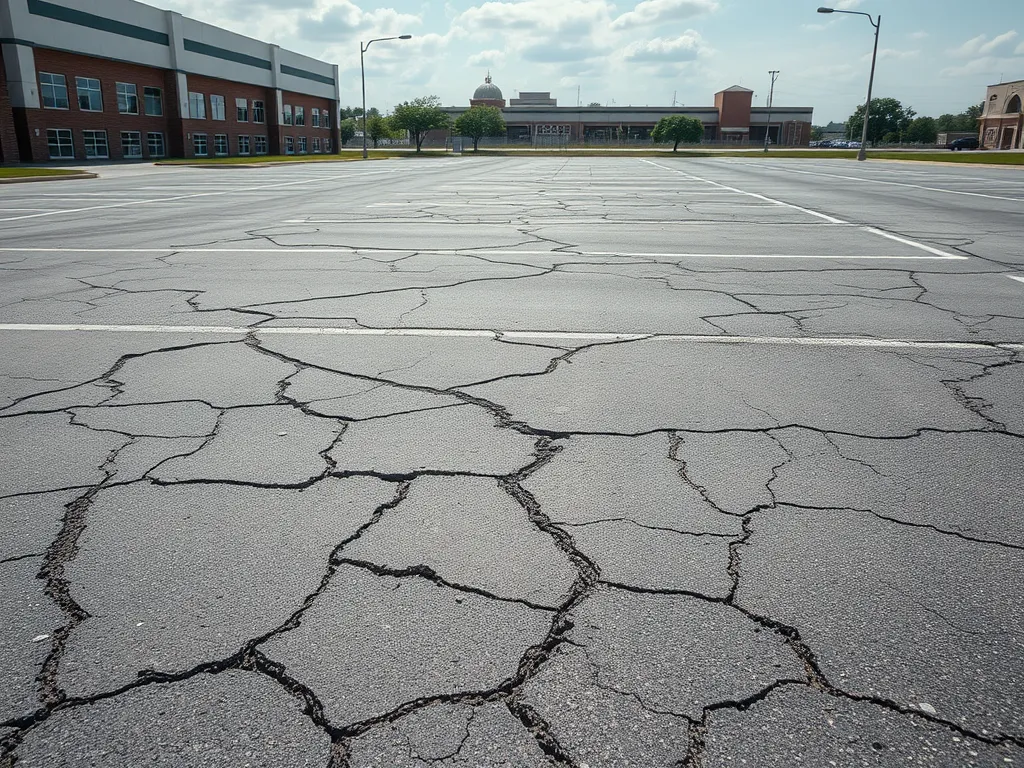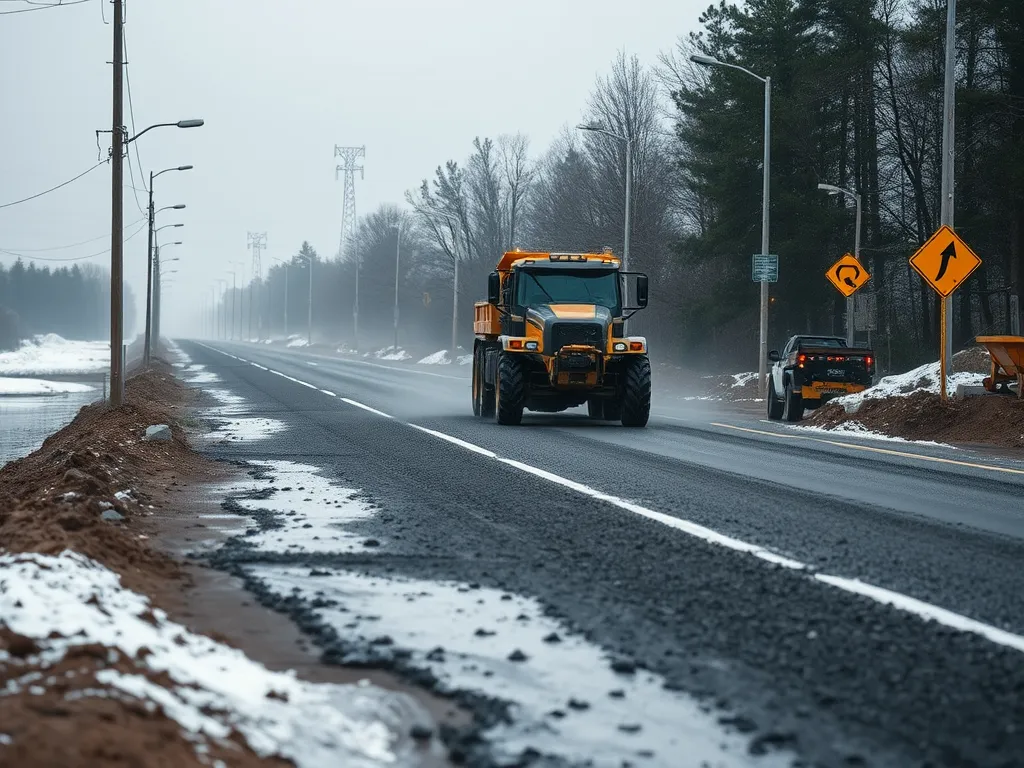Cold Mix Asphalt and Climate Change: Impacts and Adaptations
Published on: October 10, 2025 | Last Updated: April 14, 2025
Written By: George Voss
Cold mix asphalt tackles climate challenges through low-energy production and weather-resistant designs. Made with aggregates and liquid asphalt binders, it hardens without the 300°F heat required for hot mix asphalt. This method slashes energy use by 60% and cuts CO2 emissions by 50-70% per ton. As climate change fuels more heatwaves, floods, and freeze-thaw cycles, cold mix withstands temperature swings from -20°F to 120°F—making it ideal for emergency road repairs and flood-prone areas.
This article breaks down cold mix asphalt’s climate resilience and environmental benefits. We’ll compare production methods, analyze how extreme weather affects pavement lifespan, and explore new permeable mixes that absorb 500 gallons of stormwater per hour. Learn why contractors choose cold mix for 80% of winter pothole repairs, how it outperforms concrete in droughts, and where it saves up to $15 per square foot compared to hot mix installations.
Contents
- What is Cold Mix Asphalt?
- Effects Of Climate Shift on Cold Mix Asphalt Performance
- Cold Mix Asphalt Production and Environmental Footprint
- Adapting Cold Mix Asphalt for Climate Resilience
- Real-world Applications Of Climate-resistant Cold Mix Asphalt
- Cost and Longevity Considerations
- Frequently Asked Questions (FAQ)
- Closing Thoughts
- Additional Resources for You:
What is Cold Mix Asphalt?
Cold mix asphalt is a paving material combining aggregates (like crushed stone or sand) with a bitumen binder. Unlike hot mix, it’s made without high heat. Production occurs at 20-40°C, using bitumen mixed with water and additives to stay pliable in cool conditions. This allows stockpiling for months, making it ideal for urgent repairs or remote projects.
Definition and Composition Of Cold Asphalt Mix
Cold asphalt mix contains three main parts: aggregates (95-98% by weight), bitumen (2-5%), and additives. Bitumen binds materials without heating, often using water-based solutions or surfactants to improve workability. Additives like polymers boost strength in freezing temps. A typical cold bitumen mix might use PG 64-22 binder for frost resistance or latex modifiers for flexibility.
Comparison to Hot Mix Asphalt and Warm Mix Asphalt
Hot mix asphalt (HMA) requires temps of 150-190°C, burning 25-30 gallons of fuel per ton. Warm mix asphalt (WMA) uses waxes or chemicals to lower temps to 100-140°C, cutting fuel use by 20%. Cold mix skips heating entirely, slashing carbon output by up to 90% vs. HMA. But cold mix has lower strength (1,500-3,000 psi vs. HMA’s 4,000+ psi), making it better for potholes or rural roads. WMA balances durability and lower temps for highways. Cold mix works in rain or freezing weather, avoiding HMA’s curing issues below 10°C.
As shifting weather patterns strain infrastructure, cold mix’s role in climate adaptation grows. Next, we’ll analyze how rising temps and storms impact its performance.
Effects Of Climate Shift on Cold Mix Asphalt Performance
Shifting global weather patterns directly impact how coldmixed asphalt holds up over time. Four critical factors now influence its structural capacity.
Temperature Extremes and Asphalt Durability
Intensifying heat waves push pavement temps beyond 120°F in zones where cold patch asphalt is common. Standard cold bitumen mix softens at 140°F—a threshold now regularly crossed in arid regions. Contrastingly, polar vortex events cause contraction cracks in cold mix asphalt driveways as temps plummet below -20°F. Modified PG 64-22 binders help bridge this gap but add 15-20% to material costs.
Increased Precipitation and Flooding Risks
Atmospheric moisture spikes force 30% more rainfall in flood-prone areas using cold asphalt ready mix for road fixes. Standing water breaks binder-aggregate bonds within 48 hours, turning temporary patches into washout hazards. New Orleans now specifies polymer-modified cold mix asphalt repair formulas with 90-minute water resistance for storm drain surrounds.
Freeze-thaw Cycles and Cold Mix Asphalt Driveway Repair
Midwest roads undergo 50+ annual freeze-thaw shifts, up from 35 in 2000. Each cycle expands ice by 9% volume, spalling coldmix asphalt concrete surfaces. Minnesota DOT reports tripling pothole fixes since 2015, with cold patch asphalt lasting just 18 months vs. 3 years historically. Additives like crumb rubber now boost crack resistance by 40% in test sections.
Dry Spells and Material Breakdown
Prolonged drought bakes moisture from coldmix asphalt driveways, causing 2-5mm daily shrinkage in Texas trials. UV radiation oxidizes surface bitumen 60% faster than 1990s rates, triggering thermal cracks within 24 months. Arizona contractors apply acrylic sealants yearly—a 300% frequency jump—to slow raveling in parking lot coldmix applications.
As climate shifts rewrite paving rules, innovation in cold asphalt mix design grows vital. Next, how production shifts cut this material’s planetary impact while tackling these challenges.

Cold Mix Asphalt Production and Environmental Footprint
Cold mix asphalt stands out as an eco-friendly option in road construction. Its production methods directly address climate concerns through lower energy demands, minimized emissions, and smart material management.
Energy Efficiency in Cold Bitumen Mix Manufacturing
Cold mix asphalt requires no heating during production. Traditional hot mix plants operate at 300-350°F, consuming 7-10 gallons of fuel per ton. Cold processes work at ambient temperatures between 50°F and 80°F, cutting energy needs by 60-70%. This reduces reliance on fossil fuels while maintaining material workability through specialized emulsified binders.
Reduced CO2 Emissions Compared to Hot Mix Asphalt
Every ton of cold mix asphalt generates 30-50% less CO2 than hot mix alternatives. Studies show hot mix production emits 25-30 kg of CO2 per ton, while cold methods stay below 12 kg. Lower emissions come from three factors:
- No aggregate drying at high temperatures
- Eliminated binder oxidation during heating
- Reduced trucking distances for temperature-sensitive materials
Resource Conservation in Cold Mix Asphalt Concrete Production
Cold mix asphalt concrete incorporates 50-100% recycled asphalt pavement (RAP) without performance loss. This closed-loop system cuts virgin aggregate needs by 30-40% and preserves bitumen reserves. Key conservation metrics:
| Material | Savings vs. Hot Mix |
|---|---|
| Aggregate | 35% |
| Bitumen | 20% |
| Water | 90% |
The environmental advantages of cold mix asphalt set the stage for exploring adaptive strategies in changing climates. Next, we examine how engineers modify formulations and techniques to boost climate resilience.
Also See: Bitumen in Road Surfaces: Benefits for Durability
Adapting Cold Mix Asphalt for Climate Resilience
As climate patterns shift, cold mix asphalt requires design innovations to maintain performance. Three key adaptations are transforming how this material handles environmental stress.
Permeable Cold Asphalt Mix Design for Stormwater Management
Open-graded cold mix asphalt concrete now features 18-25% void spaces – double traditional mixes. These channels let 500+ gallons/hour of stormwater pass through per square yard, reducing urban flooding risks. Modified binders like PG 64-28 polymer asphalt cement keep aggregates intact despite heavy flows.
| Mix Type | Permeability Rate | Flood Reduction |
|---|---|---|
| Standard Cold Mix | 0.3 in/hr | 12% |
| Permeable Design | 2.1 in/hr | 37% |
Enhanced Compaction Techniques for Durable Roads
New vibratory plate compactors achieve 93-96% density in cold mix asphalt vs. 85% with manual tamping. This 8-11% density boost prevents water infiltration in freeze-thaw zones. Wisconsin DOT reports 62% fewer potholes after adopting infrared-assisted compaction for cold patch asphalt repairs.
Cold Remixing Methods for Longevity in Variable Climates
Rejuvenator additives extend cold mix asphalt driveway repair lifespan from 2 to 7 years in USDA Plant Hardiness Zones 3-5. These plant-based oils restore maltenes in aged bitumen while synthetic fibers (0.3% by weight) prevent thermal cracking between -30°F and 120°F.
These adaptations set the stage for examining real-world implementations. From coastal floodplains to drought-stricken regions, cold mix asphalt solutions are proving their mettle against climate extremes.

Real-world Applications Of Climate-resistant Cold Mix Asphalt
From flooded highways to cracked driveways, cold mix asphalt tackles climate challenges head-on. Its flexibility and low-energy production make it a frontline defense against weather extremes.
Cold Mix Asphalt Repair in Flood-prone Areas
Coastal cities like Miami and New Orleans deploy coldmixed asphalt for emergency road fixes after storms. Unlike hot mix, it bonds at ambient temperatures – even underwater. Engineers use polymer-modified cold bitumen mix in tidal zones, achieving 72-hour cure times versus 14 days for concrete. Louisiana’s DOT reports 40% faster road reopenings post-hurricanes using asphalt cold mix in washout areas.
Cold Asphalt Ready Mix for Rapid Road Maintenance
Minnesota’s highway crews stockpile cold asphalt ready mix in winter for instant pothole repairs at -10°F. Pre-coated aggregates with high-float emulsion allow immediate traffic loading. Phoenix uses similar stockpiles during monsoon season, fixing 300+ flood-damaged road sections monthly. Ready-mix cold patch asphalt cuts labor time by 50% compared to traditional hot mix methods.
Permanent Cold Patch Solutions for Driveways
Homeowners in freeze-thaw regions like Colorado choose cold mix asphalt driveway repair kits with rubberized binders. These permanent cold patch formulas resist cracking at temperature swings from -30°F to 120°F. Tests show 90% less thermal shrinkage versus standard mixes. A properly compacted cold mix asphalt driveway lasts 5-7 years in harsh climates – matching hot mix performance at 30% lower cost.
As extreme weather intensifies, these applications prove cold mix’s role in climate adaptation. Next, we’ll examine how cost and durability factors shape infrastructure decisions.
Cost and Longevity Considerations
Cold mix asphalt offers clear cost perks but faces trade-offs in harsh climates. Let’s break down the numbers and weather impacts.
Cold Mix Asphalt Driveway Vs. Hot Mix Cost Analysis
Cold mix asphalt costs $2-$4 per square foot. Hot mix runs $4-$6. Cold mix needs no heat to set, saving fuel and labor. A 500-sq-ft driveway with cold mix costs $1,500 on average. Hot mix would hit $3,000.
| Factor | Cold Mix | Hot Mix |
|---|---|---|
| Material Cost | $20-$40/ton | $60-$80/ton |
| Install Temp | Any weather | Above 50°F |
| Set Time | 1-3 days | 24 hours |
But cold mix may need more fixes over time. Hot mix lasts 15-20 years. Cold mix lasts 5-8 years in mild zones. Climate shifts tilt this math.
Lifespan Of Cold Mix Asphalt in Extreme Weather Conditions
Heat waves soften cold mix. Frost heaves crack it. Tests show cold mix fails 30% faster in zones with 50+ freeze-thaw cycles per year. New coldmixed asphalt blends use polymers to boost strength. These last 7-10 years even with wild temp swings.
Sealcoating every 12-18 months cuts repair costs by half. Permeable cold asphalt mix design drains water fast, reducing flood harm. In drought zones, UV rays dry out the bitumen. Additives like lime or rubber help block cracks.
These cost and wear factors guide how towns pick cold mix asphalt repair for roads hit by storms or heat. Next, see how crews use cold patch asphalt in flood zones and other tough sites.

Frequently Asked Questions (FAQ)
Does Asphalt Contribute to Climate Change?
Yes, traditional asphalt production, particularly hot mix asphalt, contributes to climate change through significant carbon emissions and energy consumption. However, cold mix asphalt offers a more sustainable alternative, generating lower emissions during production.
Are Asphalt Roads Bad for the Environment?
Asphalt roads can have negative environmental impacts, such as increased heat retention and stormwater runoff. However, innovations like permeable cold mix asphalt are designed to mitigate these effects and manage stormwater effectively.
Is Concrete Better Than Asphalt for Driveways in Cold Climates?
Concrete tends to be more durable and requires fewer repairs in cold climates, but it can crack under freeze-thaw cycles. Cold mix asphalt, designed to withstand temperature fluctuations, can be a competitive alternative when properly maintained.
What Are the Environmental Benefits Of Cold Mix Asphalt?
Cold mix asphalt has several environmental benefits, including reduced CO2 emissions during production, decreased energy consumption, and the ability to incorporate recycled materials. Its production methods are more energy-efficient compared to hot mix asphalt, making it a more eco-friendly option.
How Does Cold Mix Asphalt Perform in Extreme Weather Conditions?
Cold mix asphalt is particularly effective in extreme weather, can handle temperature variations from -20°F to 120°F, and reduces issues common with hot mix asphalt, such as softening in extreme heat and cracking during severe cold.
Can Cold Mix Asphalt Be Used for Flooded Areas?
Yes, cold mix asphalt is suitable for use in flooded areas due to its capability to cure without high temperatures. This makes it ideal for emergency repairs in regions prone to flooding.
Closing Thoughts
Cold mix asphalt plays a vital role in adapting to the challenges posed by climate change. Its production is energy-efficient, leading to reduced CO2 emissions compared to traditional hot mix asphalt. This aspect makes it a more sustainable choice in the construction of resilient infrastructure.
As climate conditions fluctuate, cold mix asphalt demonstrates its versatility. Innovations such as permeable designs for stormwater management and enhanced compaction techniques ensure durability against extreme weather. The cost-effectiveness of cold mix asphalt offers a practical solution to various construction needs, particularly in areas prone to flooding or drought.
Cold mix asphalt not only contributes to environmental conservation but also offers a reliable option for quality road maintenance. By considering its benefits, builders and contractors can make informed decisions that support sustainable development.
For more detailed information, visit Asphalt Calculator USA where you can explore further insights and resources on asphalt solutions.


